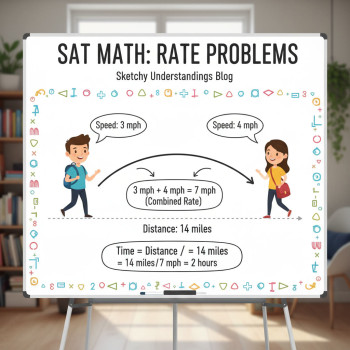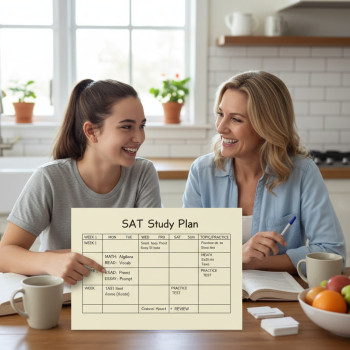The Emotional Journey of Preparing for the SAT
Preparing for the SAT is rarely just about numbers on a score report. It’s a story of late-night practice, small victories, stubborn setbacks, and surprising breakthroughs. For many students, the test becomes a mirror—reflecting not only what they know but how they handle pressure, uncertainty, and the weight of future plans. This post walks through the emotional landscape of SAT prep and offers practical ways to move from doubt to steady confidence. Along the way, you’ll find strategies, examples, and gentle reminders that you’re not alone—sometimes a tailored nudge, like Sparkl’s personalized tutoring with 1-on-1 guidance and tailored study plans, can make all the difference.
Why Emotions Matter in Test Prep
It’s tempting to think of test prep as a purely cognitive task: learn content, practice questions, improve timing. But emotions shape attention, memory, and decision-making. Anxiety can freeze recall; boredom can kill consistency; excitement can sharpen focus. Recognizing those emotional patterns is the first step toward managing them.
Common Emotional Stages Students Experience
- Initial Anxiety: The first time you open an SAT practice book or realize a test date is on the calendar, it’s normal to feel overwhelmed.
- Curiosity and Momentum: After a few practice problems and a study routine that clicks, many students feel energized. Progress is motivating.
- Plateau and Frustration: When scores stop climbing, it’s easy to get discouraged or blame oneself.
- Burnout: Too much unstructured study or unrealistic expectations can lead to exhaustion and irritability.
- Confidence and Calm: With consistent practice, reflection, and targeted help, students often arrive at a steady place where performance feels predictable and manageable.
Why this progression is normal
Think of learning like training a muscle. Gains rarely look linear—there are spikes, pauses, and slow, steady climbs. Emotionally, the ride mirrors that learning curve. When you expect fluctuations, you’re less likely to panic at a dip and more likely to use it as useful feedback.
Practical Strategies to Navigate Emotional Highs and Lows
Below are evidence-informed approaches that blend mindset, study design, and practical habits.
1. Start with small, non-intimidating wins
Begin with a 30–45 minute session that focuses on one manageable goal—read a passage actively, review one grammar rule, or do a short math section. Small wins build momentum and rewire the brain to associate studying with accomplishment rather than dread.
2. Keep a “scoreboard” for effort, not just results
Grades and practice test scores matter—but tracking effort (hours, completed sections, concepts reviewed) gives you a clearer sense of progress and helps you see the correlation between consistency and improvement.
3. Normalize plateaus and reframe them as data
If scores plateau, treat that as a diagnostic signal: which question types, which time blocks, which strategies? The plateau is an invitation to refine, not a verdict on potential.
4. Schedule micro-rests and active recovery
Study in focused blocks (for example, 50 minutes study / 10 minutes break). Short purposeful breaks—walking, stretching, talking to a friend—help consolidate learning. Sleep matters more than cramming: memory consolidation is strongest during sleep cycles.
5. Practice under realistic conditions—but vary difficulty
Taking full, timed practice tests is essential to build stamina and pacing. But also include easier sessions to reinforce skills and preserve motivation. Alternating challenging and mastery-focused sessions keeps confidence intact.
How Mindset Shapes Performance
Your mental framing—how you talk to yourself about the test—has measurable effects on performance. A few mindset shifts can be surprisingly powerful.
Adopt a growth-oriented narrative
Replace “I’m bad at math” with “I haven’t mastered this topic yet.” The growth frame invites strategy, effort, and experimentation, which are far more productive than fixed-label thinking.
Use process-focused language
Say: “I will practice 3 completed timed sections this week” instead of “I need a 1500.” Process goals reduce pressure and clarify what to do next.
Visualize the testing experience
Visualization—imagining waking up, checking in at the center or logging in for a Digital SAT, reading the first passage, and calmly working through it—can reduce anxiety by making the scenario familiar and predictable.
Study Design: Balance Structure with Flexibility
A strong plan blends a clear roadmap with room to adapt. Below is a sample weekly framework many students find sustainable.
Sample Weekly Study Framework
| Day | Focus | Time | Purpose |
|---|---|---|---|
| Monday | Reading passages + vocabulary in context | 60–90 min | Build comprehension and active reading habits |
| Tuesday | Math: targeted concept (algebra or geometry) | 60–90 min | Deep practice on weak topics |
| Wednesday | Writing & Language: grammar drills | 45–60 min | Improve editing speed and accuracy |
| Thursday | Timed practice section (any) | 60 min | Build pacing and examine mistakes |
| Friday | Review mistakes, strategic reflection | 45–60 min | Turn errors into durable knowledge |
| Saturday | Full-length practice test (every 2–3 weeks) | 3–4 hours | Simulate test day and measure progress |
| Sunday | Rest, light review, and planning | 30–60 min | Recharge and set goals for the week |
This table is a flexible template. If life gets busy, shorten or rearrange blocks—but protect at least one consistent review and one timed practice session per week.
Handling Test Anxiety: Practical Tools
When anxiety spikes—before a practice test or the real thing—use concrete tools to reduce physiological and cognitive load.
Grounding techniques that actually help
- Box breathing: Inhale 4 seconds, hold 4, exhale 4, hold 4. Repeat 3–5 times to calm the nervous system.
- 5-4-3-2-1 technique: Name 5 things you can see, 4 things you can touch, 3 things you can hear, 2 things you can smell, 1 thing you can taste. This brings attention back to the present.
- Progressive muscle relaxation: Tense and release muscle groups from toes to shoulders to release tension before a test.
Test-day routines to minimize surprises
Create small rituals that anchor you: a consistent breakfast, arriving early (or logging in with extra time for a Digital SAT), a short warm-up section of problems you find comfortable, and a quick hydration/snack strategy for breaks if allowed. Familiar rituals reduce cognitive load so your brain can focus on questions instead of logistics.
Mistakes as Gifts: Turning Errors into Reliable Gains
Errors are data. The way you analyze them is the difference between repeating the same mistake and permanently fixing it.
A clear error-analysis routine
- Record the question and your answer.
- Identify the error type (content gap, careless mistake, pacing issue, misreading the prompt).
- Restudy the concept in short, targeted bursts.
- Create a one-line rule or checklist to prevent the error next time.
For example, if you frequently miss questions that ask “which of the following best summarizes,” practice active summarization: read the passage, stop, say the gist in one sentence, then answer. This habit narrows the gap between comprehension and response.
The Role of Support: When and How to Ask for Help
Study doesn’t have to be solitary. Support accelerates progress and eases emotional burden. Help comes in many forms—classroom teachers, friends who study with you, tutors, or structured programs.
Signs you might benefit from personalized support
- Consistent plateau despite regular practice.
- Disproportionate anxiety that blocks performance on practice tests.
- Difficulty turning mistakes into long-term improvement.
- Need for accountability and a clearer, individualized plan.
When that’s the case, tailored 1-on-1 guidance can save time and mental energy. For instance, Sparkl’s personalized tutoring often includes tailored study plans, expert tutors who prioritize weak areas, and AI-driven insights to make practice more efficient—helpful when you want focused progress without guesswork.
Balancing Life and Test Prep
High school life is multi-dimensional. Friends, activities, family, and sleep matter just as much as test prep. Too many students believe sacrificing everything for the SAT is the only path to success—often the opposite is true.
Practical balance strategies
- Protect sleep. Aim for consistent bedtimes during heavy prep periods.
- Schedule study around existing commitments rather than replacing them entirely.
- Prioritize the highest-impact activities (timed practice, targeted review) over low-value busywork.
- Communicate with family/teachers about your test timeline so you can get support when you need it.
Test Day: Emotional Game Plan
Test day is the culmination—not the beginning—of your journey. The emotional goal is to stay steady: avoid spikes of panic and maintain clear decision-making.
Last-minute practical checklist
- Confirm timing and logistics—where you’re taking the test or how the Digital SAT session begins.
- Do a short, focused warm-up (one or two practice questions in the same format you’ll face).
- Use a simple breathing routine before starting each section if you feel jittery.
- If you hit a tough question, flag it, move on, and return later with fresh perspective.
Stories from the Trenches: Small Examples, Big Lessons
Real students often face familiar turning points. Here are three micro-stories that reveal larger principles.
Case 1: Maya—From Perfectionism to Progress
Maya would redo practice sections until she got them perfect, which left her exhausted and prone to burnout. Her tutor suggested a shift: complete sections once, then do a focused 30-minute review of mistakes. The result? More consistent study, less paralysis over small errors, and steady score improvements.
Case 2: Jamal—Beating Timing with Strategy
Jamal consistently ran out of time on reading passages. Instead of just practicing more, he learned triage: skim questions for keywords before reading, prioritize questions that rely on line references, and mark inference questions for a second pass. His accuracy rose because he spent time on questions he could answer confidently.
Case 3: Lily—Using Support Wisely
Lily balanced school activities and felt she didn’t have time for endless prep. She invested in occasional 1-on-1 sessions that gave her a study map and weekly checkpoints. Those targeted bursts of coaching—paired with independent practice—kept her on track without sacrificing other priorities.
Measuring Progress Without Letting Scores Define You
Practice test scores are useful signals, but they shouldn’t be the only metric that defines your worth or effort. Celebrate process wins: consistency, improved pacing, fewer careless mistakes, and deeper understanding of weak topics.
Progress tracker example
| Metric | Week 1 | Week 6 | Goal |
|---|---|---|---|
| Hours studied/week | 4 | 6 | 6–8 |
| Timed-section accuracy | 64% | 72% | 78%+ |
| Number of careless errors/section | 6 | 3 | <2 |
| Confidence (self-rated /10) | 4 | 7 | 8 |
Notice how these metrics mix objective performance with subjective confidence. Both matter because confidence influences how you perform under pressure.
Final Thoughts: Your SAT Journey Is More Than a Score
The emotional journey of SAT preparation is an education in resilience, planning, and self-knowledge. You’ll learn how you focus, how you recover from setbacks, and how to build routines that carry you beyond one test. Keep a compassionate stance toward yourself: progress takes time and often comes in jagged lines, not neat curves.
If you feel stuck or want more structured support, consider targeted help—coaching that offers 1-on-1 guidance, tailored study plans, and expert tutors who translate practice into measurable gains. Sparkl’s personalized tutoring approach, for example, blends expert instruction with AI-driven insights to pinpoint your most important next steps, all while keeping your unique schedule and stressors in mind. The right guidance doesn’t remove responsibility—you still do the work—but it helps you spend your time smarter and protects your emotional bandwidth.
Quick Takeaways
- Expect emotional ups and downs—normalizing them removes their power.
- Mix realistic practice tests with targeted, shorter study sessions.
- Use concrete anxiety tools (breathing, grounding, short warm-ups) to stay steady on test day.
- Turn mistakes into rules, not regrets.
- Get help when plateaus last too long—personalized tutoring can accelerate improvement.
Remember: the SAT is a single milestone, not the measure of your entire future. What you build during prep—disciplined habits, resilience, and strategic thinking—lasts far beyond one test day. Keep your goals in sight, but treat yourself kindly along the way. You’re learning more than test content: you’re learning how you learn.
Ready to move forward?
Pick one small action today: schedule a timed 30-minute practice block, write a single rule for mistakes you often make, or book a short 1-on-1 session to clarify your next steps. Small, consistent moves create the steady momentum that turns anxiety into achievement.















No Comments
Leave a comment Cancel